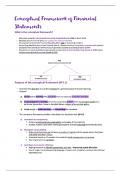Summary
Summary The Conceptual Framework Part 1
- Course
- Institution
The Conceptual Framework sets the foundation for the International Financial Reporting Standards (IFRS). This document provides in-depth and concise information on the purpose and objective of financial reporting. The document summarises the qualitative and enhancing characteristics of useful fina...
[Show more]



